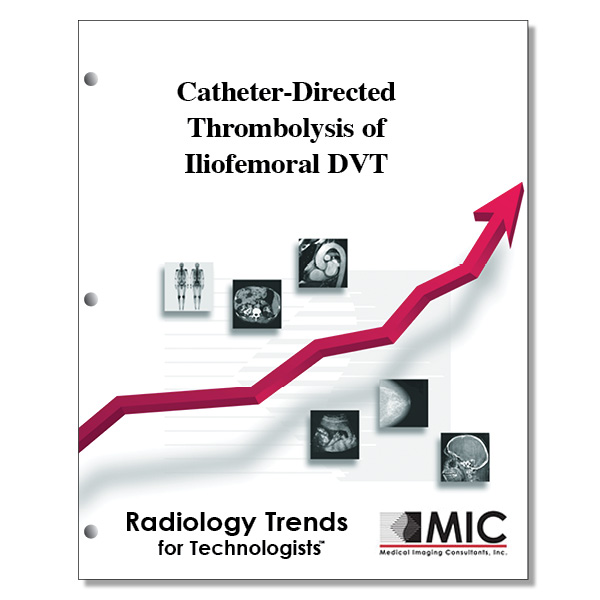

Catheter-Directed Thrombolysis of Iliofemoral DVT
Novel treatments for iliofemoral deep venous thrombosis are presented.
Course ID: Q00503 Category: Radiology Trends for Technologists Modalities: CT, MRI, Vascular Interventional2.0 |
Satisfaction Guarantee |
$24.00
- Targeted CE
- Outline
- Objectives
Targeted CE per ARRT’s Discipline, Category, and Subcategory classification for enrollments starting after February 14, 2023:
[Note: Discipline-specific Targeted CE credits may be less than the total Category A credits approved for this course.]
Cardiac-Interventional Radiography: 2.00
Procedures: 2.00
Interventional Procedures: 2.00
Computed Tomography: 0.50
Procedures: 0.50
Head, Spine, and Musculoskeletal: 0.50
Magnetic Resonance Imaging: 0.50
Procedures: 0.50
Musculoskeletal: 0.50
Registered Radiologist Assistant: 2.00
Procedures: 2.00
Neurological, Vascular, and Lymphatic Sections: 2.00
Sonography: 0.50
Procedures: 0.50
Superficial Structures and Other Sonographic Procedures: 0.50
Vascular-Interventional Radiography: 2.00
Procedures: 2.00
Vascular Interventional Procedures: 2.00
Vascular Sonography: 0.50
Procedures: 0.50
Venous Peripheral Vasculature: 0.50
Outline
- Introduction
- Clinical Evaluation
- Imaging
- Treatment Modalities
- Systemic Anticoagulation
- Systemic Thrombolysis
- Catheter-directed Thrombolysis
- Pharmacomechanical CDT and Percutaneous Mechanical Thrombectomy
- Indications for Use of Standard CDT and Pharmacomechanical CDT
- Stent Placement
- Conclusion
Objectives
Upon completion of this course, students will:
- list the goals of DVT treatment in the acute care setting
- cite the standard of care for DVT
- describe which clot types present a therapeutic challenge
- list endovascular thrombus removal and dissolution strategies
- list disease-specific factors to consider upon clinical evaluation for DVT
- name the categories for dividing the chronicity of DVT cases
- differentiate between proximal and distal regions for DVT
- list chronic symptoms of proximal DVT
- summarize imaging exams used to diagnose DVT
- state the limitations of ultrasound for the diagnosis of DVT
- list reasons to use CT or MR venography for diagnosis of DVT
- state when IVC filter placement is necessary prior to endovascular thrombolysis or thrombectomy
- list the advantages of CT venography over duplex ultrasound
- state why systemic anticoagulation is the standard of care for DVT
- recall systemic anticoagulation treatment time for acute DVT patients
- list anticoagulant medications used for systemic anticoagulation therapy
- state the major limitation of anticoagulation as an isolated therapy
- differentiate between systemic thrombolysis and anticoagulation
- state why systemic thrombolysis is no longer in clinical use
- list the endovascular thrombus removal categories
- state the most commonly used endovascular thrombus removal techniques
- recall thrombolytic agent delivery techniques
- list commonly used thrombolytic agents
- recall what imaging study should be performed post CDT
- differentiate between multiple trials for CDT
- state percentage of hemorrhage complication with CDT
- list common bleeding complications associated with CDT
- describe ultrasound-assisted CDT
- differentiate between thrombectomy techniques
- describe the isolated thrombolysis pharmacomechanical catheter-directed technique
- list the major complications associated with CDT
- recall percentage of CDT cases in which major hemorrhage is a complication
- compare and contrast the difference between pharmacomechanical CDT and conventional CDT
- differentiate between professional organizations and their guidelines for CDT
- list consequences to not placing stents for residual proximal venous stenosis
